Dr Vino's wine blog
wine talk that goes down easy
Getting plowed: Sonoma forests to vineyards
In last week’s posting about the carbon footprint of wine, I intentionally just focused on the often overlooked and carbon-intensive distribution aspects. But certainly the vineyard and winery practices need to be considered as well when looking at the environmental impact of wine.
No practice might have more impact on the environment than the act of making a vineyard out of forest. A four-minute film from the Sierra Club (thanks, Jack!) demonstrates some of this deforestation/vineyard construction in Sonoma. Using images from Google Earth, they document some vineyards already carved out of forests. Then they discuss the Premier Pacific Vineyard’s proposed development of close to 2,000 acres of forest land for 90-acre “vineyard estates,” or residences set among the vines.
On their website, Premier Pacific has a statement of environmental responsibility and commitment to sustainability:
Premier Pacific appreciates its unique opportunity to help protect the environment. We take our mandate as a responsible steward of the land seriously and have invested considerable time and resources toward designing each vineyard to be as sustainable and low impact as possible…Sustainable practices are not just environmentally responsible, but less intrusive, more natural vineyard management techniques that are being recognized as an important part of growing luxury wine.
Check out the video clip (click here if the above does not work) and feel free to sound off in the comments.
Related: ” Sonoma Coast winemakers living on the edge” [NYT]
Seeing green and being green
Eric Asimov fires off a “green wine” column for his first post-Earth Day (NYT).
One thing that struck me from the column–and that I have often encountered among many “green” producers–is their reluctance to put their method front-and-center, hoping to let the wines be appreciated on their own merits first, then as “green” wines second.
That happened last night in my NYU class when I poured the Porter Creek, Fiona’s Vineyard, 2004, a certified organic, transitioning-to-biodynamic pinot noir from Sonoma’s Russian River Valley. The wine was almost unanimously loved (find this wine). After I said that it was made organically and almost biodynamically, one participant said “why don’t they put that on the label?”
It seems there are two poles of along an axis of motivations for making green wine. On the one extreme, some producers are doing it because it’s makes good wine (and is good for the Earth). On the other, some may be doing it doing it because the sales and marketing department told them to. Or there might be a bit of both for all involved. It seems Porter Creek is on the good wine/Earth side since they don’t advertise it on their labels.
How about Fetzer with their huge Bonterra brand? I was intrigued to note on Monday here that they will be spending $1 million on marketing their wine, which states “made with organically grown grapes” on the label. Hmm, seems to have a whiff of marketing, not the terroir.
 (Incidentally, “made with organically grown grapes” need only have a minimum of 70 percent organic grapes. Truthiness?)
(Incidentally, “made with organically grown grapes” need only have a minimum of 70 percent organic grapes. Truthiness?)
Related: “Red, White and Green: can you taste the difference?” [University of Chicago, May 12]
Stomp, Portuguese style
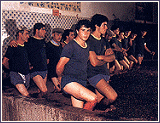 You know that caricature of someone in a vat, crushing grapes by foot to start the fermentation process? You know, the image long-ago phased out in practice for wine? Well, it turns out that nothing beats the foot in Portugal for making port.
You know that caricature of someone in a vat, crushing grapes by foot to start the fermentation process? You know, the image long-ago phased out in practice for wine? Well, it turns out that nothing beats the foot in Portugal for making port.
Only two percent of all port is still foot-crushed and it is mostly the best ports available, vintage ports. Despite some negative associations, feet are especially good at crushing the skin without crushing the seed–filled with bitter tannins–as well.
Electricity came late to the upper Douro Valley. When it did, in the 1980s, labor prices were high so producers rushed to adopt automated crushing and stainless steel closed-top fermenters. Quality fell. There was just something about those feet. Or oxygen.
The traditional lagares are made of granite and are wide, open-top vats or troughs. Somehow the exposure to oxygen provided a slight degree of oxidation that was more appealing in port, a fortified wine. David Fonseca Guimaraens told me today that his company, the Fladgate Partnership, was among the first in the region to develop mechanized foot-like pistons in open-top stainless steel vats. I didn’t ask if the pistons had toes. But Guimaraens did say that the added labor of foot crushing made it twice as expensive as mechanization.
 I tasted a sample of each of the three methods, foot-trodden from a stone lagar, piston-trodden in a stainless steel tank, and closed top.
I tasted a sample of each of the three methods, foot-trodden from a stone lagar, piston-trodden in a stainless steel tank, and closed top.
The last one was quite hollow in the middle with elevated, aggressive tannins. The piston-pressed one was much more complete, with a beginning a middle and an end with good freshness. But it was the lagar sample that had the most layers of complexity. Then there was a blind sample just to see if I was paying attention. Fortunately I got it right (the odds were good though).
In the ongoing discussion about wine and technology, it’s a cute story of the advantages of simplicity. But technology is on the march. Guimaraens says in five years, the pistons could catch the feet. They’d better keep running.
Marcel Ducasse bids adieu to Lagrange
I walked to my place. There were 14 glasses of red wine in front of me. But not just any red wine–Chateau Lagrange. I knew this was going to be good.
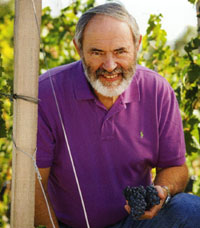 Many of New York’s A-list wine writers (somehow I was invited) turned up for lunch today at Union Square Cafe to celebrate–and taste through–the career of Marcel Ducasse. For 23 years, Ducasse has been the winemaker at Chateau Lagrange in St. Julien. He will soon be able to literally hang out his “gone fishing” sign since he will be spending time on his boat and with his family in Arcachon. Although he is a sage voice in the industry, he let the wines do most of the talking today.
Many of New York’s A-list wine writers (somehow I was invited) turned up for lunch today at Union Square Cafe to celebrate–and taste through–the career of Marcel Ducasse. For 23 years, Ducasse has been the winemaker at Chateau Lagrange in St. Julien. He will soon be able to literally hang out his “gone fishing” sign since he will be spending time on his boat and with his family in Arcachon. Although he is a sage voice in the industry, he let the wines do most of the talking today.
In late 1983, Suntory Ltd of Japan purchased the chateau for 54 million French francs (at the then-exchange rate of 8.38 francs to the dollar, that’s $6.4 million). Interestingly, one company official there today told me that they encountered some local patriotism that resented a “crown jewel” being purchased by foreigners. Although a classified growth in the 1855 classification, this “jewel” was in need of a lot of TLC. Ducasse, who was then brought on board, told us that the company has proceeded to pour ten times the original purchase price into the property. They needed 13 years stanch the losses and become cash-flow positive.
If there was one theme that Ducasse touched on today it was that the vintages are getting warmer. “When I started in the wine business, it was a miracle–a dream!–when the cabernet reached a level corresponding to 12% alcohol,” he told the gathered crowd of scribes. Now, 13% is the norm. Since 1995 the vintages have been decent, good or very good–but none has been disastrous. The summers are now warmer, drier and sunnier.
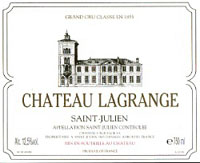 We tasted the components of the 2005 vintage–only cabernet sauvignon, merlot and petit verdot are planted on the chateau’s 115 hectares. Each good in their own right, the cabernet offered aromas of dark fruits, violets and firm tannins while the merlot–though no wimp–was softer with earthy notes and truffle aromas. The petit verdot was a tannin bolt. The blend transcended these component parts and showed a beautiful complexity at this early stage. In the excellent yet overpriced 2005 vintage, this is a tremendous value at under $50 a bottle (find this wine).
We tasted the components of the 2005 vintage–only cabernet sauvignon, merlot and petit verdot are planted on the chateau’s 115 hectares. Each good in their own right, the cabernet offered aromas of dark fruits, violets and firm tannins while the merlot–though no wimp–was softer with earthy notes and truffle aromas. The petit verdot was a tannin bolt. The blend transcended these component parts and showed a beautiful complexity at this early stage. In the excellent yet overpriced 2005 vintage, this is a tremendous value at under $50 a bottle (find this wine).
Then we moved back in time. We had a glass of each of the vintages from 1995-2004 served blind. The 2002 stood out to me as excellent and again it is reasonably priced at $50–though I found one vendor selling it for $37. At that price, this is a wine to buy by the case–get the duct tape out and seal it up for another 10 years. How do I know?
Because next we tasted the 1989 and 1990. Although these wines were from a different climatological era, they were fully resolved, delicately balanced, and hugely appealing right now. If anything, I gave the 1990 the edge but they are rewarding. And the best news of all? These lovely mature Bordeaux can be had a fraction of today’s prices since each is under $100 a bottle (find the 1990; find the 1989). If you want to taste a real claret, try is 1988. It is a trip back in time in more ways than one.
Continuity will likely be the key at Chateau Lagrange. Suntory remains the owner. And Bruno Eynard, who assumes the winemaking duties, has already been the numéro deux there for 17 years. Having raised the bar, the team aims to keep it there.
High alcohol wines, are they built to last?
 Over the holidays, Mrs. Vino and I dipped into the Vino cave to pull out some older bottles of Turley Zinfandel. With great anticipation, I uncorked the 1997 Duarte Vineyard (it had a damaged label–had to put it out of its misery; find this wine).
Over the holidays, Mrs. Vino and I dipped into the Vino cave to pull out some older bottles of Turley Zinfandel. With great anticipation, I uncorked the 1997 Duarte Vineyard (it had a damaged label–had to put it out of its misery; find this wine).
In the glass, the wine was an odd brick red in color rather than the vibrant purply inky hue of young zin. The aroma was old and tired. Prunes, raisins and a whiff of nasty. I tasted some. Big mistake. It put me in misery with port-like tastes. But that’s actually an insult to port to have any association with the wine that was so obviously past its prime.
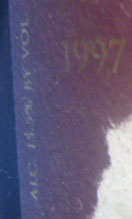 So I spit and drank some water and returned to the cave. Hmm, double down on Turley? Why not. I rummaged around to find something younger. I extracted a 2000 Old Vines (find this wine).
So I spit and drank some water and returned to the cave. Hmm, double down on Turley? Why not. I rummaged around to find something younger. I extracted a 2000 Old Vines (find this wine).
Returning to the kitchen, I uncorked it. Surprisingly thin in color, again. I was disappointed to get some of the old, dried fruit stew aromas again. But there was a whiff of cracked black pepper too. I had hope and sipped. It had some structure–prunes, a crack of pepper, then it teetered on the edge and took a swan dive into nasty land. Pl-ugh! I made Mrs. Vino take a sip for good measure. She hated me the rest of the evening. ;-(
We were in the mood for a big wine and ultimately turned to the Gran Araucano 2002 from Chile, which was very good and quickly emptied (it took a glass just to get the Turley taste out of my mouth; find this wine).
I should add that I purchased both of the Turleys from the producer when I was on their mailing list. The previous week we had opened a 1998 syrah, also purchased from the producer and stored right next to the Turleys. It tasted wonderful and seemed to still have quite a few years ahead of it.
Robert Parker frequently states that zinfandel produces a wine best enjoyed in its youth. But should he be more direct and advise drinkers NOT to age zinfandel? Should a wine of Turley’s quality (and price) not be age-worthy?
Since zinfandel is perhaps the most emblematic of the current wave of “hedonistic fruit bomb” wines–inky, extracted, approachable soon after release and high alcohol–it is reasonable to call into question the age-worthiness of the whole style. Even though the trend is not really that old, do you have experiences that would make you question whether these types of wines can be aged? Any old monster shiraz out there?
 tags: wine | Turley | aging wine
tags: wine | Turley | aging wine
Terry Theise and his merry band of small growers
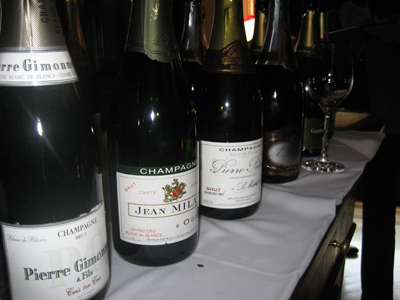
LVMH, the global luxury goods company, has a 60 percent market share of champagne sales in the US according to the IMPACT databank 2005. Their brands include such names as Veuve Clicquot, Dom Perignon, and Moet. They’re big.
Moet, like the other grandes marques, has been fabulously successful thanks to mostly buying other people’s grapes and then blending wine. In fact, the brand management has been so successful that the big champagne houses are among the most successful brands in the wine business: wide name recognition, relatively high volume, and selling at a high price point. They’ve hit the economic sweet spot. Moet sold 600,000 cases in 2005 in the US and the average retail price of each bottle was $43.50 according to Impact.
On the other end of the champagne continuum is a merry band of small growers. No, they’re not an elf-like 3’9″–they just don’t make a lot of bubbly. But that’s also a point of difference. Like a traditional “chateau,” they grow their own grapes and make their own wine.
Terry Theise, known for importing fine wines from Germany, Austria, and more recently, Champagne, spoke to a lunch of the Wine Media Guild last week about his “grower champagnes.” His spiel for grower champagne rests on three elements: value, ethics, and taste.
He argues that without the ad budgets to place products in James Bond movies, grower champagnes offer more attractive values. (But what about the economies of scale that the grandes marques employ?) And buying “farmer fizz” means supporting small family businesses. And they taste better he says.
While I was ready to be wowed, I thought that his range of champagnes was competently done but I couldn’t help but being a little disappointed. After all, I was starting to dig his logic. (My tasting notes to follow.) I should add that Theise is not the only importer of boutique, grower champagnes.
Apparently the economic sweet spot is not the only thing that is sweet about the big houses (Theise doesn’t like many of the grandes marques but he holds a lot of ire for one unnamed house in particular.) He reported to the Guild that he had done some market research and bought a bottle of the same label at shops in Paris, London and New York. All were freshly received in the shops. He sent them to the lab for chemical analysis. These were his findings, in his words:
They were different in acidity, they were different in sweetness, they were different in pH. They were not the same wine. It is an open secret in Champagne: the British get the oldest tasting stuff–not necessarily the oldest stuff. It’s because they usually put a little Spanish brandy in the dosage liqueur to give it that patina of antiquity…The French get the youngest stuff. The Americans get the sweetest stuff…We get the sweetest stuff over here that is pretty well known. Most of the big commercial brands have their dosage up tickling the legal limit.
“So what?” someone asked. The different bottlings for different markets is not inappropriate, Theise relented. “What’s inappropriate is to lie about it.”
For his merry band of growers, the trend is toward dry bringing down the sweetness, sometimes even bottling without dosage. (See my backgrounder on sweetness in champagne.) Theise and his growers occasionally argue about how dry to go. Apparently they are wanting to take the sugar levels down every year, while he tries to get them fractionally more. He said adding sugar in champagne, like salt in cooking, should not be perceptible itself but when it is present in enough quantity it makes the other aromas more pleasing or “awaken,” in his phraseology. “The issue is balance,” he said.
If you want more fighting words from Terry Theise, surf on over and read his provocative catalogue (pdf). And if you enjoy his wines, you are advised to buy them this month. Starting in January, Theise said, he’s raising his prices because his costs are going up thanks to the declining dollar.
 tags: wine | Terry Theise | champagne
tags: wine | Terry Theise | champagne
No monkeying around
 When I visited Argentina I was surprised to learn that some ten percent of the harvest each year is lost to hail. I’m sure every vineyard has a pest or a problem that attacks the juicy grapes. I’ve heard of birds and deer attacking vineyards here in New York. But on Wednesday I met with a wine maker from South Africa who loses 12 percent of his crop each year to something unusual: baboons.
When I visited Argentina I was surprised to learn that some ten percent of the harvest each year is lost to hail. I’m sure every vineyard has a pest or a problem that attacks the juicy grapes. I’ve heard of birds and deer attacking vineyards here in New York. But on Wednesday I met with a wine maker from South Africa who loses 12 percent of his crop each year to something unusual: baboons.
The 40 acres of vines on Tulbagh Mountain Vineyards abut a national park. Marauding baboons wander into the vineyard just as the grapes are approaching harvest, when the sugars are high. The vineyard owners used to lose a quarter of their crop to primates. They implemented several controls that have reduced the toll, but not eliminated it. They put up a fence but the baboons dug under it. They used patrols, but the baboons waited until the patrol was around the other side of the vineyard.
Since Chris Mullineux, the vineyard manager and wine maker, adopted biodynamics last year, he searched for a harmonious way to eliminate the pests. One British wine writer told him that the biodynamic solution to pest management was to capture a pest, burn it and sprinkle the ashes around the vineyard to deter future incursions. That was a little much for Chris to stomach in this case. A mealybug, maybe. But a baboon?
In the end, he got lion dung from a lion park in Stellenbosch and sprinkled it around the periphery of the vineyard. That proved the most effective solution. It scared the poop out of the baboons. Or, rather, it was the poop that scared them. The grape loss has been cut in half.
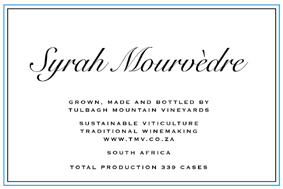
2004 Tulbagh Mountain Vineyards, Syrah Mourvedre find this wine
Winemaker Chris Mullineux doesn’t like pinotage (the taste). Nor does he like wine competitions (they favor big, extracted wines). All the grapes are hand-harvested. And the vineyard has been organically farmed since it was planted in 1999, but they’re in the first year of a transition to biodynamics, a sort of organic plus plus. Further, I know no animals were harmed in the making of this wine (see above).
This 85-15 syrah/mourvedre is a hugely serious wine. The syrah gives it tannins and spice and backbone; the mourvedre rounds it out and gives it a wild side. Minerality blends with dark berries and notes of leather to make a wine that disappears quickly from the bottle.
The bad news: 1165 cases produced. Since Chris gave me this bottle, I’m sad to report that a quick search doesn’t show any more in the US market. More details as they become available.
Tulbagh Mountain Vineyards
THIS JUST IN: the 03s are in the US–but only 339 cases were produced. The 2004s are coming. The importer is Indigo Wine Group, in Venice, FL. (941) 483 1816
 tags: wine | south africa | baboons
tags: wine | south africa | baboons
Point of controversy: yeasts!
Jamie Goode, a British wine writer, argues in Wines & Vines that “the next battleground in the wine world will be the controversial use of genetically modified yeasts.”
I disagree. American wine consumers won’t care about genetically modified yeasts in the next five years or more.
 I wish they did. It’s hard enough to get wine consumers to care about a lot of winery practices such as watering back, reverse osmosis, micro-oxygenation or wood chips. But indigenous yeasts versus commercial yeasts? Sadly, it’s a non-starter.
I wish they did. It’s hard enough to get wine consumers to care about a lot of winery practices such as watering back, reverse osmosis, micro-oxygenation or wood chips. But indigenous yeasts versus commercial yeasts? Sadly, it’s a non-starter.
GM yeasts could spark popular interest but it’s doubtful. Americans eat GM corn and GM soybeans while Europeans generally reject them. Sure, there’s a growing number of organic choices in supermarkets now but a huge backlash against GM has not hit these shores. In part, that’s because GM is confusing.
One confusing aspect is the National Organic Program and how it applies to wine. I’ll elaborate in a future post. For now, suffice it to say that the protocol allow a wine to state “made with organically grown grapes” even if that’s only 70 percent true. And it makes no mention of using GM yeasts. As Goode points out, one such yeast strain, the ML01 is now commercially and legally available in the US.
The most likely way that American wine consumers would care about GM yeasts is if foreign consumers care first. If wine consumers in the UK or Australia or New Zealand were successful in getting some wording about GM yeasts on labels, and somehow those labels made it to the US, American consumers would start asking questions. But that’s a big if.
Goode may be right in calling for a ban on GM yeasts. But I don’t see the political will in America to achieve it.
 tags: wine | yeast | jamie goode | genetic modification
tags: wine | yeast | jamie goode | genetic modification



